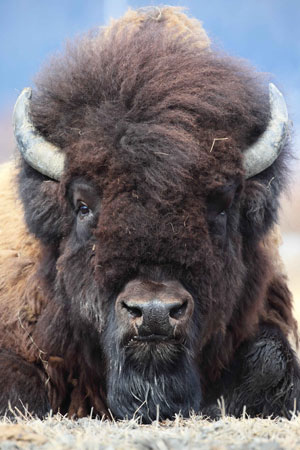
Wood Bison's Death Leaves Void That Could Slow Herd's Expansion
February 06, 2017
Bison 124 was among 130 wood bison released along the lower Innoko and Yukon rivers between April and June 2015 as part of the Alaska Wood Bison Restoration Project. The area was selected for its excellent habitat and strong community support. A wanderer that captured the hearts of rural communities across western Alaska, Bison 124 was a young cow known for its extensive exploration of the Yukon, Kuskokwim, and Innoko drainages. Residents of Grayling, Anvik, Shageluk, Holy Cross, Kalskag, Aniak, Russian Mission, Akiachuk, Kwethluk, Tuntutuliak, Eek, and Bethel welcomed the animal and enjoyed watching it explore new habitat. Many remarked that its appearance marked the beginning of more to come and should be respected. Bison 124 had a knack for identifying suitable habitat where future generations of bison could prosper, making it an important contributor to wood bison conservation. Valuable knowledge the animal gained can no longer be shared with the main herd and is now lost. As a result, the herd's expansion into the lower Kuskokwim area may require significantly more time which could delay opportunities for area residents to enjoy wood bison as a resource. "This is a sad loss," said Tom Seaton, a state wildlife biologist who oversees the wood bison restoration project. "Many local residents have called to express their disappointment with this restoration setback." Wood bison inhabited Alaska and northwestern Canada for thousands of years. Their numbers declined in the 1800s and the animals were eventually declared extinct until a small herd was discovered in Canada in 1957. From that herd, conservation efforts have resulted in about 5,000 wood bison in seven wild herds in Canada. Skeletal remains and oral histories from Alaska Natives in the eastern Interior indicate wood bison disappeared from Alaska within the past 200 years, likely from a combination of habitat change and unregulated hunting. Prior to the 2015 reintroduction, wood bison were last seen in eastern Alaska in the 1920s. Wood bison are grazers, filling a niche left empty in Alaska's boreal forest ecosystem since the animals disappeared. Wood bison are a slightly larger subspecies than the plains bison, which roam the Lower 48 plains states, and are larger and more adapted to northern areas. Population models suggest the 130 animals reintroduced to Alaska in 2015 could grow to about 250 by 2021 and to 500 by about 2030.
On the Web:
Editing by Mary Kauffman, SitNews
Source of News:
Representations of fact and opinions in comments posted are solely those of the individual posters and do not represent the opinions of Sitnews.
|
|||
